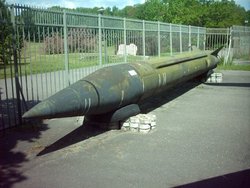Ballistic missile
|
|

A ballistic missile is a missile, usually with no wings or fins, with a prescribed course that cannot be altered after the missile has burned its fuel, whereafter its course is governed by the laws of ballistics. In order to cover large distances ballistic missiles must be launched very high into the air or in space, in a sub-orbital spaceflight; for intercontinental missiles the altitude halfway is ca. 1200 km. When in space and no more thrust is provided, the missiles are freefalling.
Long and medium range ballistic missiles are generally designed to deliver nuclear warheads because their payload is too limited for conventional explosives to be efficient, and because the extreme heat of re-entry would damage chemical or biological payloads.
Many advanced ballistic missiles have several rocket stages and their course can be slightly adjusted from one stage to the next.
Ballistic missiles can vary widely in range and use, and are often divided into categories based on range.
The US distinguishes:
- Intercontinental ballistic missile (ICBM): range greater than 5500 km
- Intermediate-range ballistic missile (IRBM): range between 3000 and 5500 km
- Medium-range ballistic missile (MRBM): range between 1000 and 3000 km
- Short-Range Ballistic Missile (SRBM): range less than 1000 km. An example is the Scud.
Medium to short range missiles are often called theatre ballistic missiles (TBM).
Using a missile with a considerably longer range than the distance from launch site to target can make sense: it can reach a higher altitude and come down with a higher speed, making defense more difficult. E.g. a missile with a range 3000 km fired at a target that is only 500 km away could arrive at its target after having reached an altitude of about 1200 km - roughly the height reached by ICBMs. Like them, it would arrive at a speed of typically more than 6 km/s.
The first ballistic missile was the V-2 rocket, developed by Nazi Germany in the 1940s, which was successully launched for the first time on October 3, 1942 and used for the first time in operation on September 8, 1944.
Specific types of ballistic missiles include:
- Ghauri missile
- Agni missile
- Blue Steel missile
- Shaheen missile
- Blue Streak missile
- Minuteman missile
- Hatf missie
- SS-24 missile
- SS-18 missile
- Peacekeeper missile
- Polaris missile
- Poseidon missile
- Prithvi missile
- CSS-2 missile
- Condor missile
- Jericho missile
- Nodong-1
- Scud
- Shahab-3
- Shahab-4
- Shahab-5
- Skybolt ALBM
- Trident
- V-2
- Surya ICBM
- Pluton
- Hades
- ASMP
- M45
- M51
- M5
launched from fixed sites, mobile launchers and submarines.
Specific types of ballistic missile submarines include:
- Benjamin Franklin class submarine
- Ohio class submarine
- Resolution class submarine
- Triomphant class
- Redoutable class
- additional ballistic missile submarines
See also: Anti-ballistic missile, Anti-Ballistic Missile Treaty, nuclear disarmament, nuclear warfare, submarine, Submarine launched ballistic missile.
External link
- http://www.fas.org/nuke/intro/missile/index.html - an introduction to ballistic missiles
- http://www.missilethreat.com/missiles/
|
Lists of Aircraft | Aircraft manufacturers | Aircraft engines | Aircraft engine manufacturers Airports | Airlines | Air forces | Aircraft weapons | Missiles | Timeline of aviation |
fr:Missile sol-sol id:Peluru kendali balistik ms:Peluru berpandu balistik ja:弾道ミサイル ru:Баллистическая ракета fi:Ballistinen ohjus zh:弹道导弹
